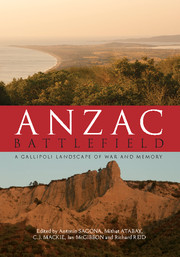Book contents
- Frontmatter
- Foreword
- Contents
- Figures
- Plates
- Contributors
- Acknowledgements
- Abbreviations
- Gallipoli battlefield place names
- Introduction
- 1 Boundary and divide: The antiquity of the Dardanelles
- 2 The Gallipoli campaign: History and legend
- 3 Recording the battlefield: First steps
- 4 Capturing the battlefield: Mapping and air photography at Gallipoli
- 5 Battlefield archaeology: Gallipoli
- 6 Forming the ANZAC battlefield
- 7 Forming the Ottoman battlefield
- 8 Artefacts from the battlefield
- 9 Remembering Gallipoli
- 10 Remembering Gallipoli from a Turkish perspective
- Conclusion
- Appendix Anzac Gallipoli Archaeological Database
- References
- Index
2 - The Gallipoli campaign: History and legend
Published online by Cambridge University Press: 05 December 2015
- Frontmatter
- Foreword
- Contents
- Figures
- Plates
- Contributors
- Acknowledgements
- Abbreviations
- Gallipoli battlefield place names
- Introduction
- 1 Boundary and divide: The antiquity of the Dardanelles
- 2 The Gallipoli campaign: History and legend
- 3 Recording the battlefield: First steps
- 4 Capturing the battlefield: Mapping and air photography at Gallipoli
- 5 Battlefield archaeology: Gallipoli
- 6 Forming the ANZAC battlefield
- 7 Forming the Ottoman battlefield
- 8 Artefacts from the battlefield
- 9 Remembering Gallipoli
- 10 Remembering Gallipoli from a Turkish perspective
- Conclusion
- Appendix Anzac Gallipoli Archaeological Database
- References
- Index
Summary
For Ottoman Army Second Lieutenant Muharrem Efendi, the battle to defend his homeland began shortly before 4.30am on 25 April 1915. A platoon commander in the 2nd Battalion of the 27th Regiment, he was waiting with 60 of his men in a trench on the high ground just above Arı Burnu point, a few kilometres north of Gaba Tepe. Peering into the darkness, he was startled to discern boats being pulled by steamboats approaching the point. His men immediately opened fire, only to be swept by return fire from a machine gun in one of the steamboats. Muharrem Efendi fell wounded and was forced to seek medical help, sustaining another wound on the way.
Once their boats were grounded, the invaders, Australians of the Australian Imperial Force's 9th Battalion, rushed up the slope. They overran the trench and headed up the slope onto the plateau above. Most of Efendi's men died, either in the trench or on the slopes above as they sought to retreat. A quarter of an hour after the first boats were grounded, another batch arrived, going ashore just north of the point. These men, under fire from Efendi's compatriots to the north, also pushed up the steep slope above them and headed inland.
This clash represented the first shots of a battle that would last eight months and would have a profound impact on all participants – and on the national identities of three countries in particular.
ORIGINS OF THE GALLIPOLI CAMPAIGN
The Gallipoli campaign had its roots in the Ottoman Empire's decision to enter the war on the side of the Central Powers and the belief in London and Paris that this decision was not wholehearted. When the war erupted in early August 1914, the Ottoman Empire faced a momentous choice: to enter the war or stand aside. A sense of insecurity underlay the approach of those who directed the empire's affairs in Constantinople. Conscious of longstanding Russian, British and French designs on imperial territory – the British were already in possession of Egypt – the Ottomans saw in Germany a source of support and protection.
- Type
- Chapter
- Information
- Anzac BattlefieldA Gallipoli Landscape of War and Memory, pp. 24 - 35Publisher: Cambridge University PressPrint publication year: 2016
- 2
- Cited by

